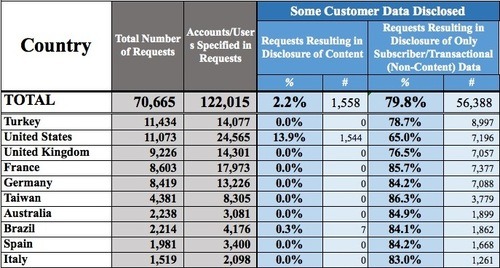Microsoft has joined Google and Twitter and this week released a transparency report about how many times governments and law enforcement ask it for information about its users. (“Caved” is how Slate described the release).
The US once again tops the global charts, filing requests involving 24,565 accounts in 2012, although it slightly trailed No. 1 Turkey in the total number of requests (11,073 vs. 11,434).
Content, such as a document or words in an email, was disclosed in 14% of the U.S. cases — one of only a small number of countries for which Microsoft ultimately released content.
Some 65% of US requests resulted in disclosing “non-content” data — a percentage that was lower than many countries. (That includes such data as IP addresses).
The UK, France and Germany followed Turkey and the US in requests and individual account totals.
Microsoft said services included in the report include email (Hotmail/Outlook.com), SkyDrive cloud storage; Messenger, Skype and Xbox.
Skype data was listed separately because that company is governed by European Union rules. Microsoft said it did not disclose any content from the 4,713 requests involving 15,409 accounts. It did give “guidance” to law enforcement in 501 of 2,847 cases in which its “compliance team found no data.”
“Content” requires a legal order or warrant to be released. It includes “what our customers create, communicate, and store on or through our services such as the words in an e-mail exchanged between friends or business colleagues or the photographs and documents stored on SkyDrive or in other cloud offerings such as O365 and Azure.”
“Non-content data” includes “basic subscriber information, such as the e-mail address, name, location and IP address captured at the time of registration.” That data is easier to get by law enforcement, requiring only a subpoena or “official, document based request.”
From this page, you can download Excel and PDF versions of the report and read a FAQ.
Chart below is an extract from a Microsoft table and shows statistics for the Top 10 countries.

